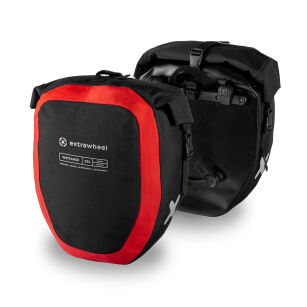Fenders: Essential for Rainy Riding
Fenders are a crucial component, especially when cycling in the rain and after rain. They allow you to continue your journey on wet surfaces without worrying about getting splashed from the wheels. Even after rain showers, when it stops raining, fenders enable you to stay in the saddle all day without the need to stop and dry off.
Bicycle Lights: Safety Comes First
For your own safety, it's worthwhile to equip your bicycle with lights. I recommend small LED lights, such as Frog models, which are not only affordable but also lightweight. These lights come in handy, especially when riding in the rain, at night when searching for accommodations, or even when passing through mountain tunnels. In some countries, bicycle lights are a mandatory piece of equipment, so it's not worth taking any risks.
Kickstand: Stability During Breaks
Propping up your bicycle during stops or longer breaks can be a bit challenging. Some cyclists skip using a kickstand and lean their bikes against various obstacles. However, a loaded touring bike can easily tip over, especially in light wind or on uneven terrain. Therefore, it's worth investing in an adjustable-length kickstand, which may be a bit heavier but provides stability even in challenging conditions.
Pre-Expedition Bicycle Service: The Key to Trouble-Free Travel
Before embarking on any longer journey, it's essential to perform a thorough bicycle service. Proper functioning and lack of breakdowns are the keys to a successful trip. Equipment issues can spoil the joy of riding and lead to unplanned stops. Repairs and the replacement of bicycle parts abroad can often be costly and time-consuming, so it's better to take care of your bike before the trip. By inspecting and lubricating bicycle components such as the chain, cassette, bottom bracket, derailleurs, brakes, and tires, you can avoid many troubles along the way.
Taking and Using a Bicycle Helmet on Trips: Protection on the Road
A bicycle helmet is an incredibly important piece of equipment that can save your life in the event of an accident. During long bicycle trips, many travelers downplay this aspect and do not bring a helmet along. However, on longer routes, especially during fast descents, a helmet is absolutely essential. A bike with luggage behaves differently in challenging conditions, so head protection is crucial. You can easily attach a helmet to your bike, luggage, or stow it in a pannier or transport bag. In some countries, wearing a bicycle helmet is mandatory, so it's best to be prepared.
Listening to Music While Riding: Entertainment on Long Stretches
Listening to music while cycling can be a pleasant addition, especially on long and monotonous stretches of the route. Favorite tunes can help you maintain a steady riding rhythm and increase travel comfort. However, safety should always come first. In places with heavy traffic or in conditions where extra caution is required, it's advisable to turn off the music to ensure you can hear your surroundings.
Bicycle Computer with Altimeter: Assistance in the Mountains
A bicycle computer is a useful tool that not only provides information about your current speed, ride time, and distance covered but can also be equipped with an altimeter. In the mountains, elevation differences matter, so knowing your altitude above sea level can be invaluable. This information allows you to calculate how many meters you have left to climb or what elevation you will reach at the summit.
Spare Batteries: Avoid Unexpected Failures
Before setting out, it's always a good idea to replace the batteries in your bicycle computer and carry spare batteries with you. This way, you can avoid unexpected equipment failures on the road and ensure you can make full use of your computer's features.
SPD Pedals on the Trip: Comfort and Efficiency
Using SPD shoes and pedals can enhance riding comfort and efficiency. This solution is particularly popular among long-distance cyclists. It provides stability to your foot and better power transmission to the pedals. However, it's important to ensure the cleats are properly adjusted in the shoes to avoid numbness in your feet during long rides.
Expedition Engineer: Support from Home
During longer, solo expeditions, it's valuable to have a trusted person back home who can assist in case of problems on the road. This person can help with booking public transport tickets, finding accommodations, or contacting the Polish embassy abroad if necessary. Before departure, it's a good idea to provide them with your expedition plan, contact information, and essential details.
(Non) Safety: Caution on the Road
Road-related dangers mainly stem from traffic situations. However, solo travelers can also become targets for equipment theft. Therefore, it's a good idea to bring bicycle locks with you to secure your bike against theft. While riding, always exercise caution.
Summary:
Preparing for a bicycle expedition is a multifaceted process that requires attention to many aspects, proper equipment, and care for your gear are key to successful bicycle journeys. Safety, comfort, and riding efficiency depend on various factors, and meticulous control of your bike's condition and proper preparation are crucial.
Thanks to this, you can enjoy beautiful landscapes along the route, set new records, and explore the world on two (sometimes three) wheels, with the confidence that your bicycle and equipment are ready for any challenge. Because bicycle expeditions are not just trips; they are true adventures. Connecting with nature, discovering new places and cultures, active relaxation, and personal growth are just some of the benefits of traveling by bike. When planning your next expedition, remember to prepare adequately, use maps and GPS to help you succeed on your journey. Are you ready for a cycling adventure? Hop on your bike and venture into the unknown!









 Polish
Polish
 German
German
 French
French